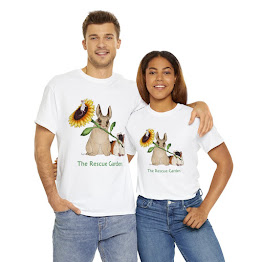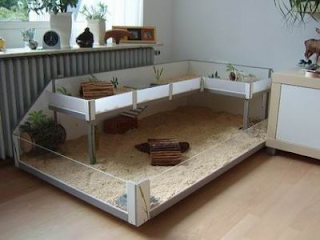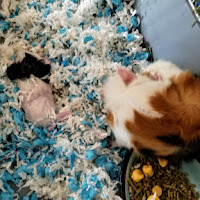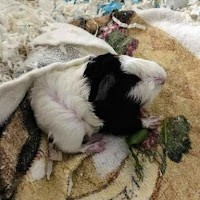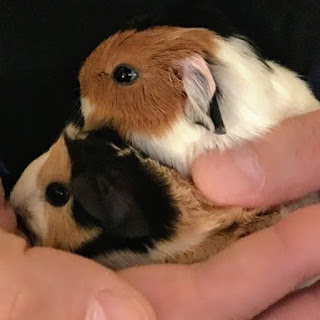I love Pinterest, Instagram, and any other highly-visual medium for the inspiration they bring in so many areas. Unfortunately, these types of platforms have also been extremely active in spreading well-meaning but inaccurate information about what constitutes appropriate housing for various small pet species.
When the focus becomes stronger on the aesthetics of a pet home than the safety or suitability, tragedies can occur. Animals in houses that are too small can develop obesity, depression, or neurological disorders; if the house itself is made out of unsafe materials, the consequences can be illness or worse. The super-cute hutch that appears on your feed may not be worth the risk to your beloved pet.
At The Rescue Garden, we follow the basic guidelines set forth by The Humane Society to determine whether a pet home is suitable:
Guinea pigs: Minimum 2ft wide and 8 sq ft flat floor space for 1 to 2 guinea pigs; add another 2 sq ft for each additional guinea pig in the enclosure.
Rabbits: Ideally rabbits should have free range of your rabbit-proofed home, but minimum 16 sq ft flat floor space at least for when you're asleep or not at home; add another 4 sq ft for each additional rabbit. Even a dwarf or mini-rabbit needs a minimum height of 36in on enclosure walls to ensure they can't jump out of them.
Rats: At least 2 floors/levels for 1 to 2 rats, with the main floor being 2 sq ft x 2ft tall; for every additional 1 to 2 rats, double these measurements.
Mice: 23in x 20in with a height of 12in and a minimum of 2 floors/levels for 1 to 2 mice; for every 1 to 2 mice added, add 30 sq in and 1 level.
Rabbits and guinea pigs love to roam, but not so much climb. Any hutch or cage that includes multiple levels and/or steep ramps may result in injuries and a fearful pet who will stay hunkered down on their too-small main floor, especially if those ramps are just plunked into a hole in the middle of the top floor where they could fall. Rats and mice are happy little daredevils, though, so while they take up less floor space, they absolutely need that additional height to keep them healthy and happy.
Spacing between bars also matters:
- Mice can slip through any bars wider than ½in apart.
- Adult rats can get through wider than 1in.
- Baby guinea pigs -- as old as 8 weeks -- can pop through the standard C&C grids.
If needed, you can make temporary "baby gates" by clipping solid sheets of clear plastic or other suitable materials over the outside of the bars, but I'd like to stress temporary until your pet grows large enough to no longer need the extra protection. They'll be much happier and safer if their adult cage is suitable for their species!
These guidelines should apply even if you're only going to keep your pet in their enclosure while you sleep, or when you're not at home. Think about how many hours you sleep on average, or how long a trip to the store might take. Even if you're asleep, your pet might not be. Guinea pigs are neither strictly nocturnal or diurnal, staying up for most of the day but also a portion of the night while you're asleep. Rabbits are crepuscular, meaning they are most active at dawn and dusk. Now imagine how rotten it is to be wide awake and ready to go, but be trapped in a small space with nothing to do... especially now, as we all do our part to prevent the spread of COVID-19 by practicing social distancing and self-quarantining as necessary, we should be extra-sympathetic to that!
Size isn't the only consideration you should have in setting up a safe and happy space for your pet, though. Small pets are prey animals in the wild, meaning that very noisy environments will have them constantly terrified and stressed, which can shorten lifespans, affect handleability, and ultimately mean a less satisfying bond for both you and your pet. Avoid exposing your pet to sudden loud noises, shrill noises, or any kind of ultrasonic noise from things like jewelry cleaners, humidifiers, or aromatherapy diffusers -- even though we can't hear it, they definitely can, and ultrasonic noise has been shown to disrupt neurological function to the point of permanent damage or sometimes even death in many animals, but especially rodents and other small animals. (It's why ultrasonic noise is used for "organic" pest control.)
Air temperature, and humidity must also be properly controlled. Guinea pigs, especially, are extremely prone to heat stroke, and once they start showing symptoms, it's often too late to bring them back. Very dry (less than 15% humidity) or dusty environments can cause respiratory issues in small pets, but too much humidity can also cause deadly bacteria, fungus, mildew, or mold to grow unchecked. Mice and rats are prone to hypothermia due to their low body fat content. As a general rule, ideal temperatures are:
- Rabbits: 60F-72F. Never over 78F, never below 35F.
- Guinea pigs: 64F-76F. Never over 80F, never below 60F.
- Rats & mice: 65F-80F. Never over 82F, never below 62F.
Good airflow in any cage is beneficial in conjunction with safe temperatures and humidity, since it helps prevent respiratory illnesses and stops bacterial growth. If airflow is insufficient, even the best possible temperatures outside the cage will become unbearable and maybe even dangerous to your pet inside of it. For animals like mice and rats who prefer to hide, lots of small boxes, pet-safe houses, tunnels, and other accessories should be places inside their enclosure for them to play in. Keeping the cage against a wall with just a few inches of space will give them the whole side of a gridded enclosure without limiting airflow like fish tanks will -- a contributing factor to the number of pet store-purchased animals who come home with fungal infections and respiratory illnesses. Regardless, you should always keep an eye on your pet's enclosure; if you see any signs of mold, mildew, or extra liquid saturation in the bottom, remove your animals immediately and get a new one.
And finally, light is one of the most important considerations for the happiness and health of any animal, including humans. The instinctual behaviors of our small pets, including sleep and foraging, are tied to the cycles of the sun, also known as their circadian rhythm. If there's too much bright light in their house, a small animal used to a natural forest-like environment or otherwise darker environment (mice and rats) will be negatively affected. On the other hand, if you have a rabbit or guinea pigs, not enough light can actually cause depression. Nocturnal animals and any with red or pink eyes tend to be more sensitive to light. Type of light matters too; fluorescent lights and LED lights should be avoided, since they can damage the sensitive eyes of rats and mice and disrupt neurological function. Some anecdotal evidence also suggests that rabbits may be affected in similar ways, so it's best to nix them altogether. Flashing or strobing lights can also cause neurological damage, and lights should be turned on and off with the natural cycle of the day -- that is, don't worry about night-lights for your pet, since nocturnal animals see well enough in the dark that they won't need them, and diurnal animals will be negatively impacted.
Here's a guide to some of the most common small pet houses -- or at least styles of them -- that we've been asked about.
1. The Cute "Rabbit" Hutch
This is a very cute piece of furniture sold as a rabbit hutch, but it is far too small, and the multiple levels make it a poor choice for either a rabbit or guinea pigs. In fact, we have yet to see any of these super-cute "bunny" hutches that are sufficiently big enough for them (with the exception of some very nice custom builds). Even with a multi-story hutch, the ramps take up a huge amount of space by the ramp openings on the top and bottom, so whatever the total square footage is, you are losing at least an additional foot on each floor to accommodate the way up and down -- and for guinea pigs, there's a real risk of falling through the hole in the floor and injuring themselves (or worse). Burrowing animals like rabbits may sleep in small, dark spaces, but if their main habitat is always dark, you could potentially throw off their natural circadian rhythms and end up with a very unhappy and possibly sick pet. We couldn't find information on the bar spacing, but if they're narrow enough, this could be a fine option for rats or mice.
2. The "Hiding In Plain Sight" Cage
This style is popular for folks who prefer to blend their pet housing into their regular surroundings -- and if done correctly, this isn't a bad choice! We like the fact that there are lights installed inside, since guinea pigs dislike small, dark spaces for their main habitat. With smaller grids on the front, this would be a great rat condo; a few extra levels with less space between them and even smaller grids, and you could make a whole lot of mice very happy.. We'd even consider it for up to 2 guinea pigs if it were built to have more floor space and either ditched the second level or at least had a ramp that was not so steep, if you happen to have one of the rare piggies who doesn't mind them. This is definitely too small for a rabbit, though.
3. The Indoor Garden
WE. LOVE. THESE. ENCLOSURES. Plenty of open space, and whether you go with the grid-type fencing or acrylic siding, any guinea pig or rabbit would be lucky to live in something like this. The top "house" in the second photo can easily be repurposed for storage or just used as decoration, though we don't recommend using it as a second level due to how small it is -- even a very slight ramp would still leave not enough floor space for your pet to safely turn around inside and use it. It should go without saying, however, that rats and mice could very easily scamper their way to freedom with this style.
4. The Simple Pen
"Hey! That's what I've got for my rabbit!" exclaimed our social media manager when she saw this.
Sold as a pet exercise or playpen, these metal pens measure 16 sq ft in a square configuration and are easy to set up. They aren't fancy, but they're plenty of room for a single rabbit or a herd of up to 4 guinea pigs, and if you've got other free-roaming animals in the house, there are different kinds of toppers you can purchase specifically to fit them. The bars are way too far apart for mice or rats to safely live in, though. As a note, make sure any fairy lights or decorative garlands are well out of reach of nibbles to avoid intestinal blockages or a nasty electric shock to your pet.
5. The Double-Decker
Obviously, your pet's comfort should take ultimate priority -- but we can't help mentioning how much we love the easy access that this style of cage door offers. This particular model can fit up to 3 rats or 7 mice if you add an extra couple of levels; however, this style is unsuitable for guinea pigs or rabbits due to the required floor space being divided between two levels, and the ramp required to move between them being too steep to safely use.
6. The "Compact" Option
My initial urge was to just write an entire paragraph of "NO" in bold font for this one. For anything other than a single mouse -- and even then, the grid would need replacing with something much smaller so they couldn't slip out, and an extra level would have to be added -- this is far too small, dark, and miserable. Keeping an animal in something like this is nothing short of cruelty. If space is a consideration, there are other, better options out there that won't produce a miserable and definitely unhealthy pet.
7. The Upcycle
If you're handy with tools and have a bulky old entertainment center around, you may be able to re-purpose it as shown here... but with this specific build, not for guinea pigs, and definitely not for rabbits, due to the lack of flat space for them to run around. With the appropriately smaller grids than the big chicken-wire fencing shown, this would be absolutely divine for a pair of ferrets, at least 4 rats, or a whopping 10 mice. There are plenty of IKEA hacks out there for small animal enclosures, too, if you'd prefer some step-by-step instructions instead of designing something off the top of your head. I've done this before, with the caution that at least one whole side and at least most of the opposite side should be gridded to ensure healthy airflow (and sometimes the top of the cabinet, depending on size and configuration).
8. The Pet Store Option
Anyone who's ever been to a pet store may now be asking, "but what about the tiny, cute cages they sell there?" It's a very uncomfortable truth, but the fact is that they don't take the time or resources to train their employees in proper animal care, meaning that while the helpful sales person helping you pick out your pet's new home may mean well,
they probably have no idea that they're recommending an unsuitable and potentially dangerous cage. Corporate pet stores, especially, avoid the better housing options, which sometimes require more assembly than the lousy ones, because they don't want to scare folks off and affect their bottom line. The reality is that they make no profit from the animals they sell; all of their income is from the supplies and housing, which is yet another excellent reason to
adopt instead of shop!
On their own, these kinds of pet store options are too small even for a single mouse to live in. If you're willing to get a bunch of connector tubes and several more of these cages, though, it would be fine -- in fact, the small print on the box for many of these even calls out that they are not suitable individually and must be set up as part of a much larger "playground" network. But for all of the money you'll spend doing that and the space it'll likely take up, you're better off going with any of the other mouse-approved enclosures in this list.
Of course, there are so many more styles and models of housing out there for your small pet that it can be overwhelming to decide which one is best. If you're not sure, we're happy to have you contact us via
Twitter or
Facebook with your housing questions! We want to be sure that both animal and owner have everything they need to make a lasting bond and stay healthy and happy.



 back of card
back of card

